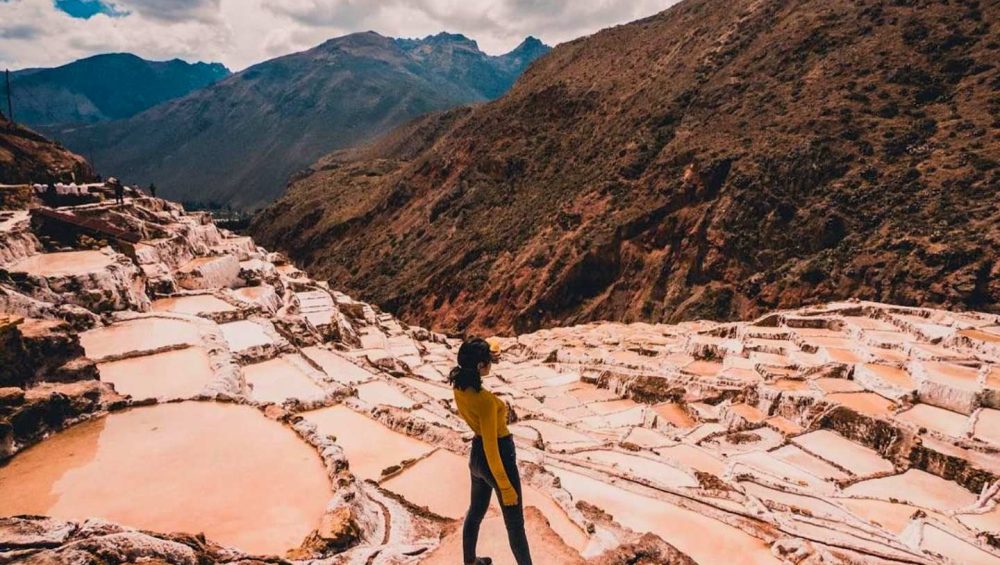In the Sacred Valley of the Incas is one of the most unique landscapes in Peru: the Maras Salt Mines. This impressive set of over 3,000 salt pools extends along the slope of the Qaqawinay hill, forming a white and ocher mosaic that dazzles whoever visits it.
The Maras Salt Mines represent much more than a tourist attraction: they are a cultural legacy that remains active until today. Since pre-Inca times, local families have extracted salt from these pools fed by a natural spring with high mineral content.
Visiting this place will allow you to learn the history of this corner of Peru, discover the wisdom of the ancient Incas, and appreciate how community work and the relationship with nature remain an essential part of life in the Andes.
What are the Maras Salt Mines?
The Maras Salt Mines are a set of over 3,000 salt pools arranged in terraces that descend the slope of the Qaqawinay hill, in the Sacred Valley. These formations, created and maintained by local families since pre-Inca times, take advantage of a natural spring with high salt content to produce crystals that are then dried in the sun.
The contrast between the white, pink, and brown pools with the blue of the Andean sky creates an impressive landscape, considered one of the most photogenic in Peru. More than a visual attraction, the Maras Salt Mines are a sample of Andean cultural heritage and the ingenuity with which its inhabitants learned to live and work with nature.
History of the Maras Salt Mines
The origin of the Maras Salt Mines is wrapped in history and legend. One of the most popular versions comes from the “Legend of the Ayar Brothers”. According to this story, Ayar Cachi, brother of Manco Cápac, had enormous strength capable of opening mountains with a single stone. Fearing his power, his brothers locked him in a cave on the Qaqawinay hill. It is said that his tears, loaded with anger and sadness, filtered through the mountain, giving rise to the salt water that today feeds the Maras pools.
Another version, more historical, holds that the Salt Mines were naturally formed by processes of erosion and sedimentation thousands of years ago. It is believed that the Wari culture was the first to take advantage of the salt sources, organizing the extraction of the mineral with community techniques. Later, the Incas perfected the system, building the tiered terraces and channels that are still used today.
Currently, the Maras Salt Mines Peru continue to be a heritage. Each pool belongs to a local family that inherits and cares for it, maintaining an ancestral tradition that combines history, work, and respect for nature.
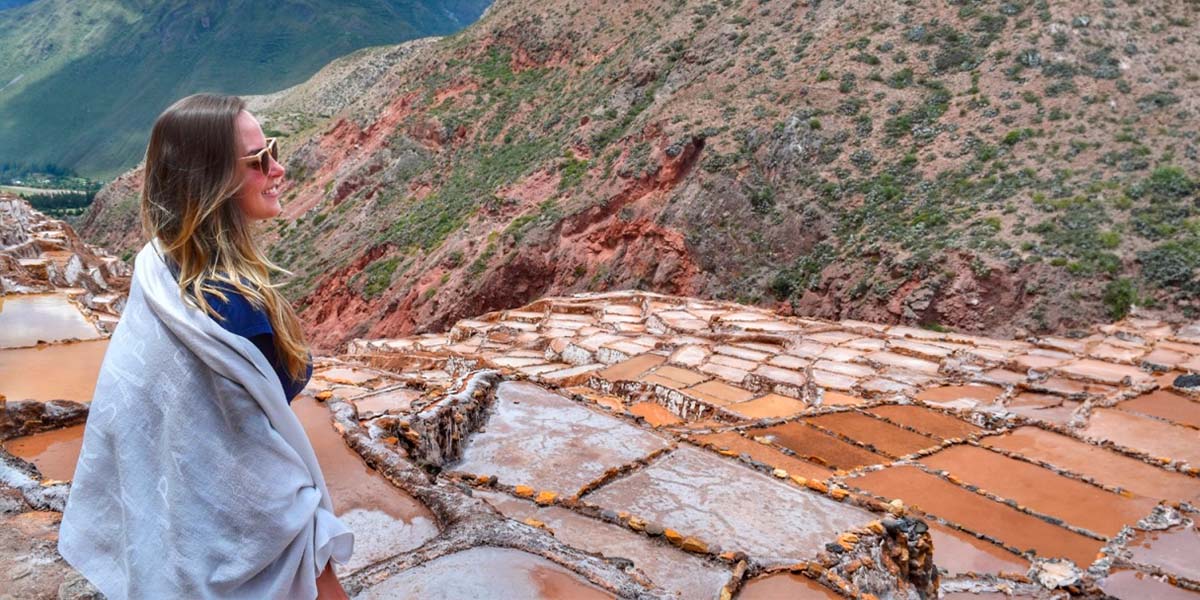
Where are the Maras Salt Mines?
The Maras Salt Mines are located 46 kilometers from the city of Cusco, in the Sacred Valley of the Incas. This natural and cultural complex is made up of thousands of shallow pools located on the slope of the Qaqawinay hill, about 3,380 meters above sea level. Fed by a mineral-rich underground spring, these salt terraces make up one of the most impressive landscapes in Peru and represent an ancestral legacy that continues to be a source of work and pride for the families of Maras.
When to visit the Maras Salt Mines? The best time of year for your trip
Visiting the Maras Salt Mines is a fascinating experience any time of year, but each season offers a particular charm. Planning your trip according to weather conditions and the flow of visitors can make a difference in your experience. Below is information about the seasons to choose the ideal time to enjoy this incredible destination in the Sacred Valley.
Dry season (May to October)
- Clear skies and spectacular views: During the dry season, sunny and clear days offer an impressive view of the white and ocher mosaic of the pools, with a unique contrast against the blue sky of the Andes.
- Pleasant weather for touring: With mild temperatures and minimal chance of rain, walking through the terraces and surrounding areas is comfortable and safe. It is also the perfect time to combine your visit with other nearby destinations like Machu Picchu, the rainbow mountain, and other destinations.
- Full and bright pools: The pools are usually overflowing with salt water, which creates natural reflections that make the landscape an unrivaled visual spectacle.
- High season: Being the most popular time, you will find a greater influx of tourists. It is recommended to book both transportation and accommodation in advance to avoid inconveniences.
Rainy season (November to April)
- Green landscapes: The rains transform the Sacred Valley into an environment full of life, with mountains covered in vegetation and a fresher atmosphere. The views are different, but just as charming.
- Quieter environment: The lower number of visitors makes this season an excellent option for those looking to enjoy the place calmly.
- Pools with less water: In some months, the pools may be partially dry or have less water, offering a different landscape that reveals the natural structures and shapes of the mines.
- Weather recommendations: Although the rains can alter some plans, bringing waterproof clothing and planning with flexibility will allow you to fully enjoy this experience.
Are the Maras Salt Mines really worth it?
Definitely yes. Despite the altitude, this place offers a natural and cultural spectacle that amazes every visitor. The salt terraces, with their white and pink tones that contrast with the landscape of the Sacred Valley, are a unique visual experience and a display of Andean tradition.
- Recommendation: Don’t let the altitude stop you from visiting this destination and other tourist attractions in Cusco. With good acclimatization and proper preparation, you can enjoy this impressive destination without problems.
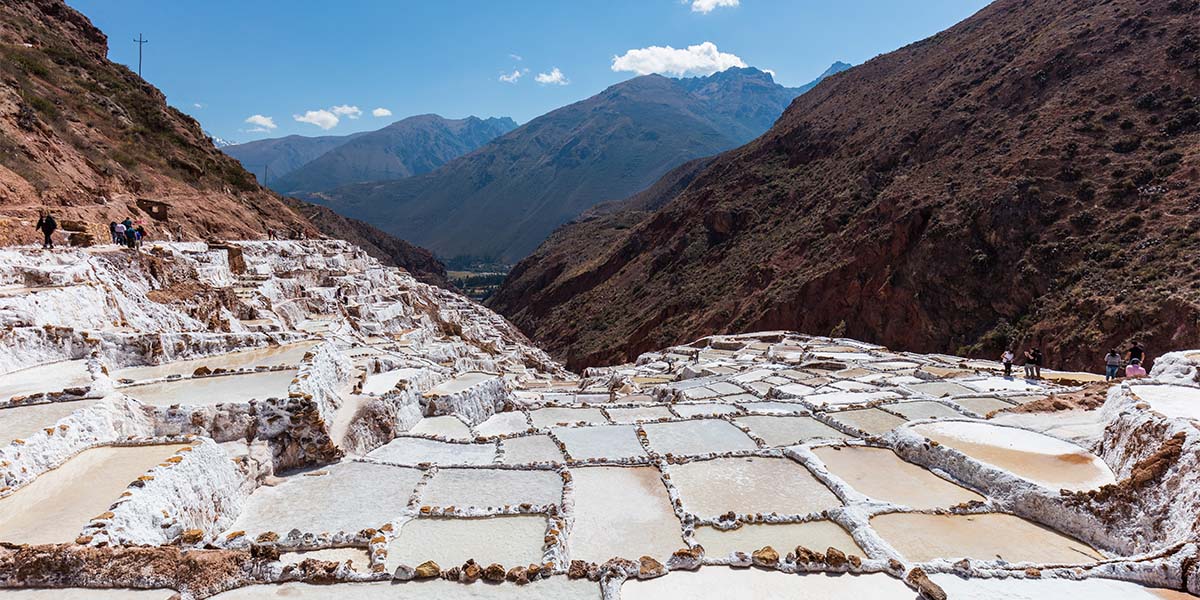
The importance of the Maras Salt Mines
The Maras Salt Mines, in the heart of the Sacred Valley of Cusco, not only make up one of the most surprising landscapes in the Andes but also represent an ancestral tradition that has lasted for centuries. Their origin dates back to pre-Inca times, when local communities already took advantage of the salty water that flows from the Qaqawinay mountain. This ingenious system of terraces and canals reflects the deep knowledge of Andean cultures about the earth and water. Today, the salt mines symbolize the union between cultural heritage and nature, a legacy that deserves to be protected and valued for its historical and sustainable importance.
Gourmet Product: Maras Salt
Maras Salt is a culinary treasure from Cusco, appreciated for its texture and flavor. Coming from the natural pools, its purity and composition make it a special seasoning to enhance meats, fish, vegetables, or salads. This artisan product, used since ancient times, has gained recognition in Peruvian and international gastronomy. If you visit Cusco, you are likely to find it in many typical dishes or in local stores, where it is presented as an authentic souvenir of the Sacred Valley.
Discovering the Maras Salt Mines
To make the most of your visit, here are essential tips, tours, and activities that will make your adventure unforgettable.
What to bring: Preparation for the weather and the walk
- Appropriate clothing: During the dry season (May to October), wear light and comfortable clothing. In the rainy season (November to April), bring waterproof clothing and water-resistant footwear.
- Sunscreen and hat: Solar radiation can be strong, so protect your skin with sunscreen and use a hat for shade.
- Water bottle and snacks: Stay hydrated during the walk and bring some energizing snacks to recharge.
- Quality camera: Capture the vibrant colors of the Salt Mines and the Sacred Valley with a good camera.
- Light backpack: Opt for a comfortable backpack to carry your essential belongings without difficulty.
Sacred Valley of the Incas
- Guided Tour: Explore the Maras Salt Mines as part of a broader tour of the Sacred Valley of the Incas.
- Includes Other Attractions: Check if the tour covers other outstanding attractions of the Sacred Valley, such as Ollantaytambo or Pisac, for a complete experience.
- Transportation and comforts: Make sure the tour offers comfortable transportation and amenities for a worry-free day.
Mountain biking in Moray and Salinas
- Active Adventure: This tour combines the excitement of mountain biking with the exploration of Moray and the Salt Mines. Perfect for those who enjoy outdoor activities and staying active.
- Specialized equipment: Check if the tour provides quality bicycles and safety equipment to guarantee a safe and exciting experience.
- Expert guides: make sure you have expert guides who know the area and provide detailed information during the tour.
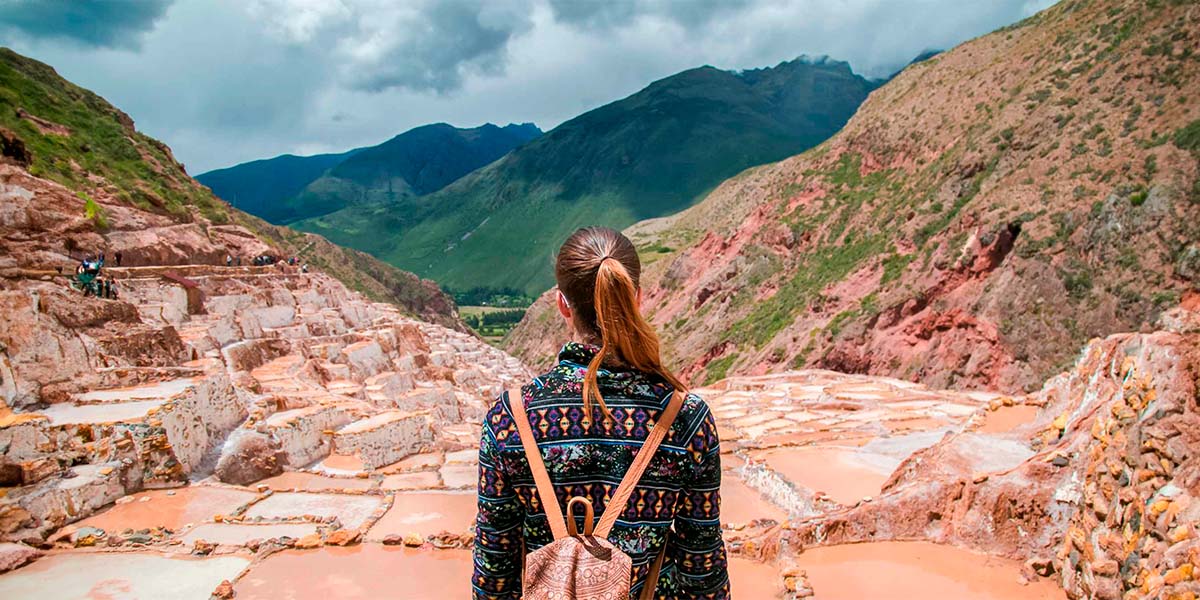
How to get to the Maras Salt Mines, Cusco?
The Maras Salt Mines are located about 10 kilometers from the town of Maras and approximately 50 kilometers from the city of Cusco. To get there, you can take a bus or colectivo from Cusco toward Urubamba and get off at the tour to Maras, where you can continue by taxi or moto-taxi to the salt mines. However, the most practical and popular option among visitors are the organized tours, which include transport, guide, and entrance to the site, guaranteeing a comfortable and hassle-free visit.
Options to get there:
- Organized Tour
-> Advantages: Greater comfort, professional guide, direct transport, and included access.
-> Recommended for: Families, travelers looking for a guided and worry-free experience. - On your own
-> Advantages: More economical, flexible, and with the possibility of making additional stops along the way.
-> Recommended for: Adventurous travelers or those who prefer to explore at their own pace.
Transport options:
- Public transport: Trip duration: 1 hour and 30 minutes / Price: 10–15 soles.
- Shared taxi to Maras: Trip duration: 30 minutes / Price: 5–7 soles.
- Shared taxi to the salt mines: Trip duration: 15 minutes / Price: 5–7 soles.
Additional Information
- Entrance Cost to the Salt Mines: S/ 15.00 soles or 4 USD per person.
- Opening hours: From 7:00 a.m. to 5:00 p.m.
- Recommended visit time: 2–3 hours.
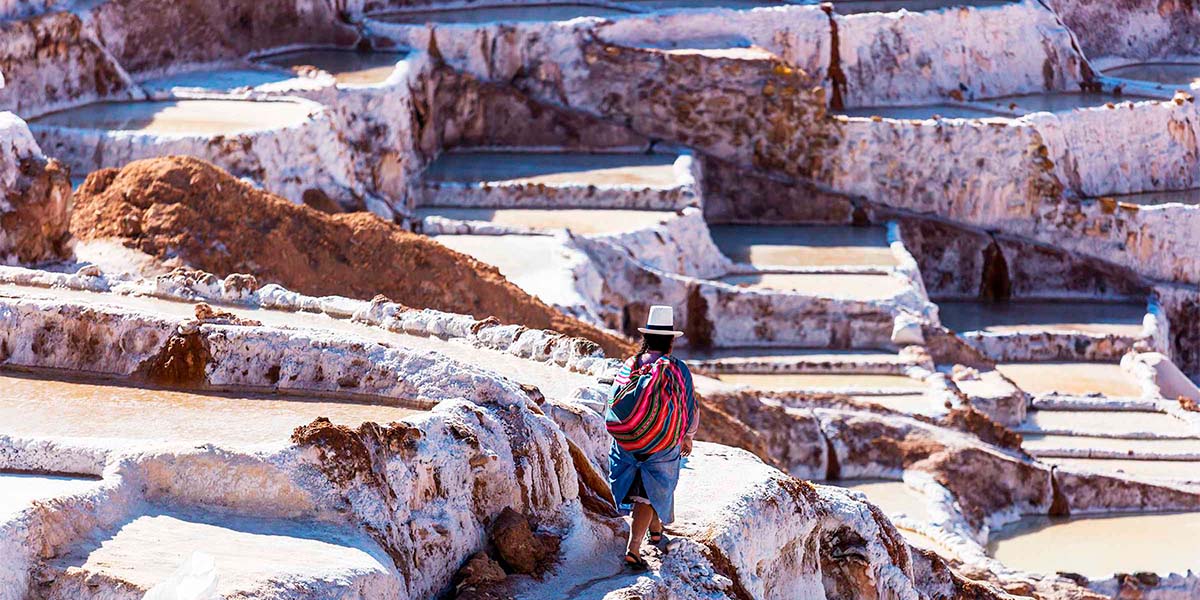
Sacred Valley Tours: Explore beyond the ordinary
Explore the Sacred Valley with tours that combine history, culture, and unique landscapes. Each route offers a different experience, ideal for those who want to see beyond the usual and discover the treasures of the Inca legacy.
Treasures of the Inca Empire
- Machu Picchu: Tour the most famous Inca citadel and contemplate its amazing architecture.
- Ollantaytambo: Visit its fortress and agricultural terraces, symbols of Inca power.
- Pisac and Chinchero: Explore the ruins of Pisac and the traditional town of Chinchero, a place full of cultural heritage.
Natural and Cultural Wonders
- Moray: See its circular terraces, an ancient Inca agricultural laboratory.
- Maras: Admire the impressive salt mines that are still active.
- Urubamba: Enjoy its natural environment and local cuisine.
Route of the Sun
- Intipunku (Sun Gate): Contemplate one of the most spectacular views toward Machu Picchu.
- Ollantaytambo: Tour its ancestral architecture and history.
Adventures in the Heights
- Pisac and Ollantaytambo: Discover their ruins while enjoying a hike through the Andes.
- Moray Summit: Reach the top and contemplate unparalleled panoramas of the Sacred Valley.
Hidden Treasures
- La Merced Church (Chinchero): Admire the mix of colonial and Inca art.
- Textile Community: Learn about the ancient weaving methods and share with the local artisans.

